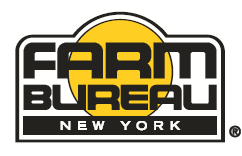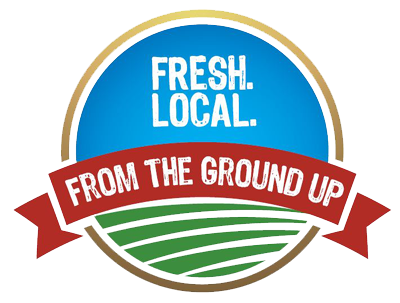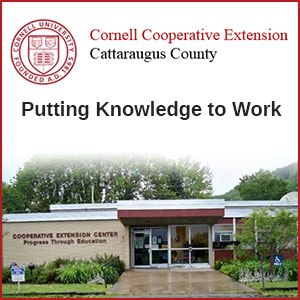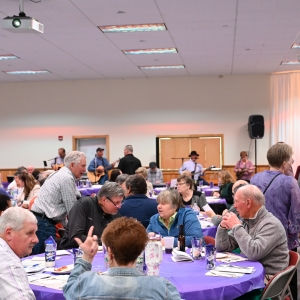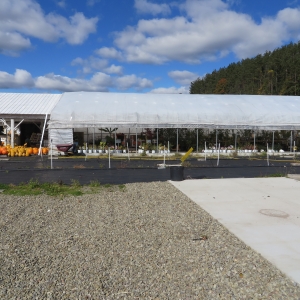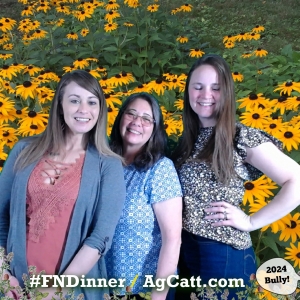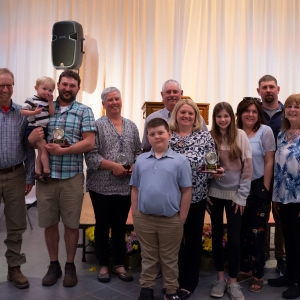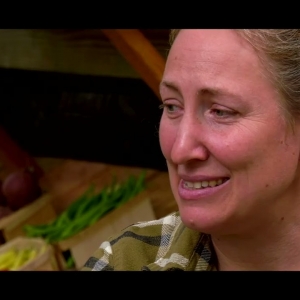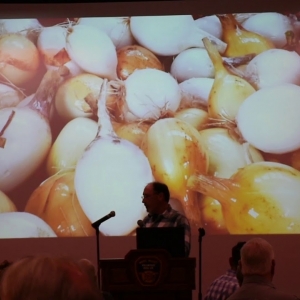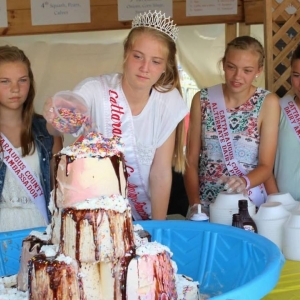Other Ag News: The Future of Small Farming is Fungi
Gesturing toward thousands of neatly aligned logs — some sprouting mushrooms, others with mycelial potential hidden from sight beneath rugged bark — Steve Sierigk, the co-owner and co-operator of Hawk Meadow Farm, welcomed visitors to the forest where he grows his mushrooms. The scene, both organic and orderly, harmonized with the towering pines that framed the laying yard.
Steve Sierigk, co-owner and co-operator of Hawk Meadow Farm, speaks to workshop attendees about how to inoculate a drilled log bolt. Rich Mattingly / Cornell Small Farms Program
“Shiitake grown on logs isn’t just about food, it’s about land stewardship,” he explained to rapt workshop participants, his affable voice ringing through the sun-dappled clearing. Steve described the delicate partnership between artful log arrangement and care and the wild nature of the fungi, which he has grown for four decades. “When we cut some trees to become mushroom logs we then also encourage or plant others, and you become an active participant in where the forest is going. It becomes a beautiful cycle.”
In October, Hawk Meadow Farm near Ithaca, NY, hosted a hands-on shiitake cultivation workshop, sponsored by the Cornell Small Farms Program, drawing a diverse group of gardeners, homesteaders, and farmers from underserved communities, eager to learn the art of growing shiitake mushrooms from logs. The workshop blended ecological philosophy and historical context with practical skills, from inoculating logs to fostering resilient farm ecosystems.
“The highest quality mushrooms are grown this way, in harmony with the land,” said Steve, emphasizing the decentralized, small-scale ethos of the practice: “In Japan a shiitake farm may have half a million logs. Here, it’s a few thousand. But every log represents a softer ecological footprint compared to other growing methods, and it feeds the soul.”
Shiitake cultivation in Japan began centuries ago when wild shiitake was collected in the forest, long before modern, log-based methods were used. “Shiitake” means “mushrooms of the shii tree,” one of the trees on which shiitake grows that has similar qualities to oak. Shiitakes have long been highly prized for their flavor and there are centuries-old examples of their use in folk medicine. Samurai warriors, living near forests where shiitake grew, often forbade others from collecting it, coveting it for its health benefits
Worldwide, shiitake is the second most-cultivated mushroom after the common white mushroom westerners may be more familiar with. Shiitake’s popularity goes beyond flavor. When cooked, it imparts a full-bodied aromatic but distinctly pleasant umami taste to the dish while maintaining its own original color and chewy texture. Fresh shiitake resists both bruising and spoilage remarkably well compared to other commercially grown fungi. Dried shiitake, which is also widely available commercially, is convenient and inexpensive to store and transport. The USDA has published research showing shiitake exposed to sunlight while drying can store the daily recommended adult minimum requirement of vitamin D in just a single gram, thanks to a natural chemical compound called ergosterol.
Shiitake’s rich history and culinary appeal set the stage for a deeper understanding of its role in sustainable agriculture at the workshop. At Hawk Meadow Farm, this tradition isn’t just preserved – it is actively cultivated through hands-on education in modern, small-scale farming practices.
Heather Gable, workshop participant, steadies a log bolt on a frame used for inoculating logs with mushroom spawn. Rich Mattingly / Cornell Small Farms Program
Gathering the workshop participants in a convivial circle near the beginning of the workshop, Steve and Anne Sierigk explained the origin of their mushroom growing enterprise. “Shiitake was pretty much unknown in the US in the 1980s. It wasn’t allowed to be grown domestically because the USDA was afraid it would escape mushroom yards and become invasive. Buying dried, imported mushrooms was the only way you could get them. In 1976 the ban was lifted as it was realized that shiitake was not aggressive,” explained Steve, continuing, “I got into it through the macrobiotic diet community in Ithaca. There were maybe 1,000 macrobiotics in the area, and we would have these big potlucks. I was in a circle that really embraced that diet. We would buy mushrooms in bulk from Japan and one day I saw an article about growing it in the traditional Japanese style in logs in the woods. I thought I might try it on a garden scale and things grew from there after these techniques proved to be successful.”
From these early beginnings, Steve and Anne built Hawk Meadow Farm into a hub for sustainable shiitake cultivation, where their knowledge now supports a new generation of growers. The spirit of stewardship was on full display at the workshop, where participants weren’t just learning to grow mushrooms but also engaging with a philosophy that intertwines ecological care, food security, and economic resilience.
Connor Youngerman, Cornell Small Farms Program Agroforestry and Mushroom Specialist, displays a log with shiitake mushrooms fruiting for workshop participants while Anne Sierigk, co-owner and co-operator of Hawk Meadow Farm looks on. Rich Mattingly / Cornell Small Farms Program
Connor Youngerman, agroforestry and mushroom specialist with the Cornell Small Farms Program, echoed this vision. “Shiitake cultivation combines sustainable woodlot management, economic diversification, and food security,” he said. “It’s a system that’s easy to learn, scalable, and sparks creativity. Everyone should grow mushrooms!”
Participants took turns practicing drilling holes into cut hardwood logs, or bolts, inserting spawn, and sealing the holes with wax – a process requiring precision, but easy to learn. María José Oviedo Ventura, a bilingual agricultural educator with the Cornell Small Farms Program, ensured Spanish-speaking farmers could fully engage. “Live translation allowed attendees to ask direct questions and contribute to discussions,” she said. “It transformed the space into one where everyone belonged.”
The workshop also bridged experience levels. Tricia Park, a farmer previously enrolled in the Cornell Small Farms Program’s outdoor mushroom course on a veteran scholarship, aims to harvest her first crop this fall. “Customers want this,” she said. “It complements our farmstand and connects people to resilient food systems. Since we have been farming for a couple of decades already, we have our core enterprises of grassfed beef, pasture and woodland-raised pork, and a market garden that supplies our farmstand plus a small maple syrup operation, firewood, and skin care products. Any added enterprises have to be carefully thought through in order to fit in with all that. Growing shiitake on logs should fit in and complement what we do now while helping us with resiliency both on our land and with our bottom line.”
Park appreciated the workshop’s practicality. “I saw how to stack logs, deter slugs, and use tools like the angle grinder adapter – small details that prevent big headaches,” she said. “The hosts’ low-cost, low-infrastructure approach proved this is doable.”
Beyond technique, the day repeatedly highlighted mushrooms’ role in regenerative agriculture. “Every log is an act of stewardship,” Steve noted. “We manage these woods for long-term health, culling invasives and planting species like locusts and white oaks. The trees we nurture will outlive us. We are meant to be around trees and forest health is key to climate and soil stabilization” Youngerman added, “Shiitakes build climate resilience. They recycle hardwood waste into food, enrich soils, and promote healthy forests.”
Anne Sierigk says the process of growing mushrooms doesn’t just help the forest land she stewards but helps her heal herself. “I think about how stressed people are in our culture – how they work endlessly, chasing an end goal, but often their jobs don’t feed their souls. We have that perspective of being over 70 and a lot of people our age are missing out on being healthy. We love being in the woods and being outside. During our workshops we like to make people think about their connection with the work – what are you doing that nurtures yourself? Stress is a huge factor in how healthy we are. I urge people to find that joy in life. Find whatever it is that feeds your soul. You have to have fun and if you’re not, you have to reexamine your life.”
Steve, echoing Anne’s sentiments, said, “The thing about fun is even if I have a deadline and it starts to feel like drudgery while sorting mushrooms and filling orders…when I’m doing all that stuff I think about how remarkable this all is. That I’m outside and creating habitat and it’s really cool that my job is growing high quality healing foods while improving our woodlands and creating wildlife habitat. It humbles you, and you feel grateful that you’re one little piece of a grander natural design system.”
For the workshop participants standing around a dunking tub, where the spawn logs are regularly immersed to encourage production, the topic of discussion moved to the economic viability of scaled-up production.
Steve, fielding questions, explained, “When you’re trying to visualize something, like an enterprise, it’s easy to go to a place where you want to maximize your production. We’ve become generalists, just like some of the mushroom species we grow. We can tell if the scale stresses us out and you’ll have to make that decision for yourself and your farm. At one point, we were getting a lot of good leads for how to expand the mushroom log business and getting approached by larger companies about producing secondary products. It was feeling like we were in a factory, and we had to do what felt right for us.”
Assisted by Connor Youngerman (L) Cornell Small Farms Program Agroforestry and Mushroom Specialist looks on as Brendan Gaffney drills holes in a log bolt with a specialized bit attached to an angle grinder, one of the techniques workshop participants were instructed on. Rich Mattingly / Cornell Small Farms Program
For attendees like Olga Nedlin, a budding farmer veteran seeking land to start her own shiitake enterprise, these lessons on balancing scale and sustainability provided a realistic roadmap for launching their own mushroom enterprises. “I realized how simple it could be. I want to start with 1,000 logs. I did the math and six hours of work a day once the logs are going could make it viable for me,” she said. Her motivation? “Once you taste fresh shiitake from the air fryer, you have to have more.
One Spanish-speaking participant reflected after the workshop on why he decided to invest in shiitake cultivation: “It was a mix of things. I had seen them in the market before, and I noticed that many people bought them. Also, when I made a list of all the instruments needed, I realized I already had most of them, or that buying what I was missing wouldn’t be too expensive. I even had wood for the logs. Therefore, we decided to primarily grow shiitakes, but also experiment with other mushrooms in small quantities to see how customers would react.”
The workshop also helped him determine the cost versus benefit of growing shiitakes. “Steve mentioned a lot of numbers and details, like the pounds he could yield from a log. Afterward, my family and I calculated the costs and decided it was worth the investment. We’ve started to incorporate shiitake, and we think it could be expanded in the spring or next season.”
As the late-lingering sun stretched golden fingers across Hawk Meadow Farm, Steve took in the group’s energy. “The future of agriculture lies with small farms. When people see how this work nourishes both the land and their own futures, they leave inspired.”
Participants departed not just with inoculated logs, but with a deeper understanding of their connection to something greater. Steve’s parting words underscored his belief that growing mushrooms in the woods is more than a method — it’s an act of collaborative stewardship and community building. “There are countless support networks within this decentralized movement to help you start and sustain outdoor mushroom cultivation. But this community is about more than economics. This isn’t just farming — it’s taking part in something timeless that connects us deeply to nature.”
The post The Future of Small Farming is Fungi appeared first on Cornell Small Farms.
Signup for the Ag Newsletter
Get the freshest farm news, events and updates from in and around Cattaraugus County, NY at least once a month! Go signup!
Other ways to stay connected:
Get Involved in Farming
Resources for Starting a Farm in Cattaraugus County
Profile of Cattaraugus County soils
Agriculture Career Exploration
Questions about farming? Find out Who to Call

